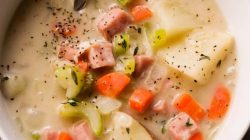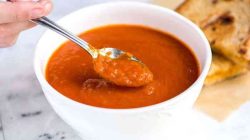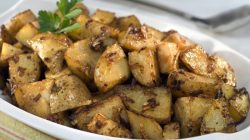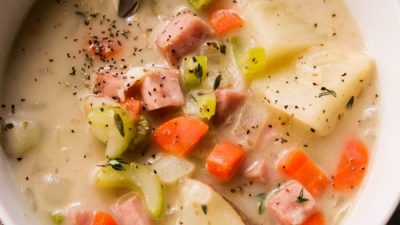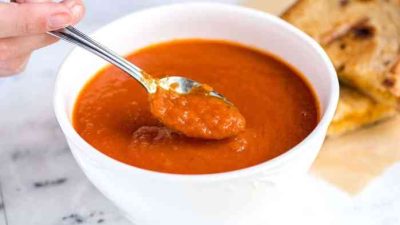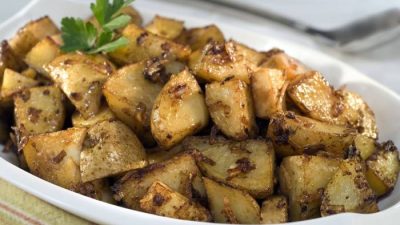Bean and Bacon Soup: A Hearty and Flavorful Classic
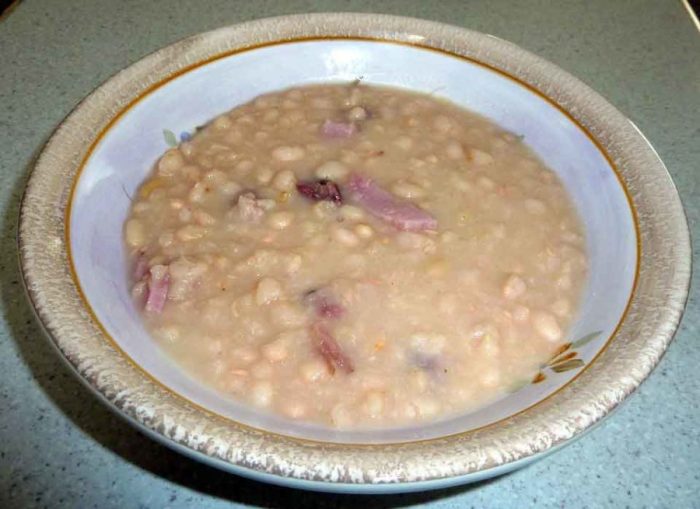
Source: foodgasmrecipes.com
Recipe for bean and bacon soup – Bean and bacon soup, a comforting dish enjoyed across various cultures, boasts a rich history intertwined with the readily available ingredients of its time. Its origins are difficult to pinpoint precisely, as variations of bean and cured meat stews have existed for centuries. However, its enduring popularity speaks to its versatility and satisfying nature. The cultural significance varies widely; in some regions, it’s a staple winter warmer, while in others, it represents a celebratory or festive meal.
The possibilities are endless, ranging from simple farmhouse fare to sophisticated culinary creations.
Bean and Bacon Soup: Origins and Cultural Significance
The combination of beans and cured pork, the foundation of this soup, has ancient roots. Beans, a crucial protein source for many cultures, were cultivated across the globe. Similarly, various forms of preserved pork, including bacon, have been integral parts of diets for centuries. The specific combination likely emerged from practical considerations: readily available ingredients, efficient preservation methods, and a nourishing result.
While precise origins remain elusive, its widespread adoption points to its inherent appeal. In some cultures, it holds special significance during holidays or celebrations, while in others it’s a daily comfort food. The specific beans and type of bacon used often reflect regional culinary traditions.
Types of Beans and Bacon
The choice of beans and bacon significantly influences the final flavor profile of the soup. Common bean varieties include kidney beans (offering a firm texture and slightly sweet taste), pinto beans (known for their creamy texture and earthy flavor), and navy beans (smaller and milder in flavor). Similarly, the bacon options are diverse: smoked bacon lends a smoky depth, thick-cut bacon adds a richer, meatier flavor, while Canadian bacon offers a milder, sweeter alternative.
Bean and Bacon Soup Recipe Variations
Numerous variations exist, each showcasing unique flavor profiles depending on the chosen ingredients. Below is a comparison of three distinct recipes, highlighting the impact of different beans, bacon types, and broths.
| Name | Bean Type | Bacon Type | Broth Type |
|---|---|---|---|
| Classic Bean and Bacon | Kidney Beans | Smoked Bacon | Chicken Broth |
| Creamy Pinto Bean Soup | Pinto Beans | Thick-Cut Bacon | Vegetable Broth |
| Simple Navy Bean Soup | Navy Beans | Canadian Bacon | Water (with Bacon Fat) |
The differences in bean types directly affect the texture and taste. Kidney beans maintain their shape, offering a hearty bite, while pinto beans become creamy and contribute a subtly sweet flavor. Navy beans, being smaller, soften more quickly and provide a milder, more delicate taste. The type of bacon used also impacts the flavor profile. Smoked bacon infuses a deep smoky note, thick-cut bacon adds a richer, more intense flavor, and Canadian bacon provides a milder, sweeter counterpoint.
Slow-Cooked Bean and Bacon Soup: Step-by-Step Procedure
This method allows the flavors to meld beautifully, resulting in a deeply satisfying soup.
- Sauté diced bacon until crispy, removing and reserving the bacon bits.
- Add chopped onions and carrots to the bacon fat and sauté until softened.
- Stir in beans, broth, and seasonings (salt, pepper, garlic powder, etc.).
- Bring to a boil, then reduce heat and simmer for at least 2 hours, or until beans are tender.
- Stir in the reserved bacon bits before serving.
Pressure Cooker vs. Slow Cooker
Both pressure cookers and slow cookers are suitable for this recipe, each offering distinct advantages and disadvantages. Pressure cookers significantly reduce cooking time, achieving tender beans in a fraction of the time compared to slow cookers. However, some might find the intense heat of a pressure cooker alters the subtle flavors. Slow cookers, on the other hand, allow for gentle, long-simmering, which develops richer, more complex flavors.
The choice depends on individual preferences and time constraints.
A hearty bean and bacon soup is a comforting classic, perfect for a chilly evening. For a different take on creamy comfort food, you might also enjoy a richer dish like the pork chops and rice recipe with cream of mushroom soup , which offers a delightful contrast in flavors. However, if you’re seeking a more rustic and wholesome meal, returning to the simplicity of bean and bacon soup is always a satisfying choice.
Achieving the Perfect Consistency
The desired consistency can be controlled by adjusting the amount of liquid. For a thicker soup, reduce the amount of broth or simmer uncovered for a longer period to allow excess liquid to evaporate. For a thinner soup, simply add more broth. A potato or two added during the cooking process can also contribute to thickening.
Serving Suggestions and Accompaniments
Bean and bacon soup is best enjoyed with a variety of complementary side dishes and a visually appealing presentation.
- Cornbread
- Garlic bread
- Simple green salad
- A dollop of sour cream or crème fraîche
Serve the soup in rustic bowls, garnished with fresh herbs (like parsley or chives), a sprinkle of extra bacon bits, and a swirl of olive oil. The warm earthy tones of the soup, contrasted with the vibrant green of the herbs and the glistening bacon bits, create a visually appealing presentation.
Leftovers can be stored in airtight containers in the refrigerator for up to 3 days. Reheat gently on the stovetop or in the microwave, avoiding boiling, to maintain the best texture and flavor.
Nutritional Aspects and Health Benefits
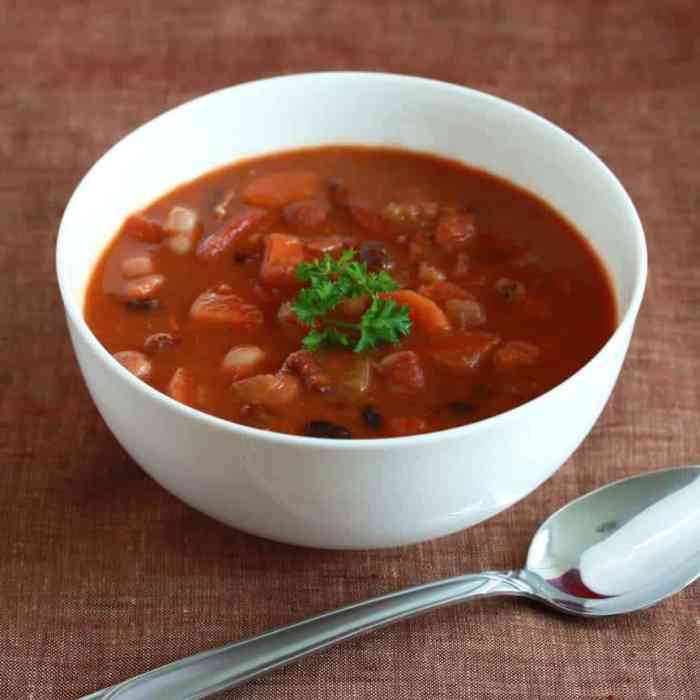
Source: daringgourmet.com
Bean and bacon soup offers a balanced nutritional profile, though its health benefits are dependent on the specific ingredients and portion sizes.
| Nutrient | Amount (per serving, approximate) | Unit | Benefit |
|---|---|---|---|
| Protein | 20 | g | Supports muscle growth and repair |
| Fiber | 15 | g | Promotes digestive health |
| Iron | 3 | mg | Essential for oxygen transport |
While beans are rich in fiber and protein, the bacon adds saturated fat and sodium. Regular consumption should be balanced with other healthy foods. To enhance the health profile, reduce the amount of bacon, increase the proportion of vegetables (like carrots, celery, or spinach), and use low-sodium broth.
Troubleshooting and Tips for Enhancing Flavor, Recipe for bean and bacon soup
Several common issues can be easily addressed, and simple adjustments can elevate the soup’s flavor.
- Overly Salty Soup: Add a peeled and diced potato to absorb excess salt during the simmering process.
- Beans Not Softening: Ensure beans are properly soaked beforehand (especially dried beans). Add a bay leaf during cooking to aid in softening.
- Enhancing Flavor: A splash of Worcestershire sauce or a teaspoon of smoked paprika adds depth of flavor. Toasting the beans lightly before adding them to the soup brings out their natural sweetness.
Quick FAQs: Recipe For Bean And Bacon Soup
Can I use canned beans instead of dried?
Yes, canned beans are a convenient substitute. Rinse them thoroughly before adding them to the soup to remove excess sodium.
How long can I store leftover soup?
Store leftover soup in an airtight container in the refrigerator for up to 4 days.
Can I freeze bean and bacon soup?
Yes, bean and bacon soup freezes well. Allow it to cool completely before freezing in airtight containers for up to 3 months.
What if my soup is too salty?
Add a peeled and diced potato to the soup and simmer for 15-20 minutes. The potato will absorb some of the excess salt.




